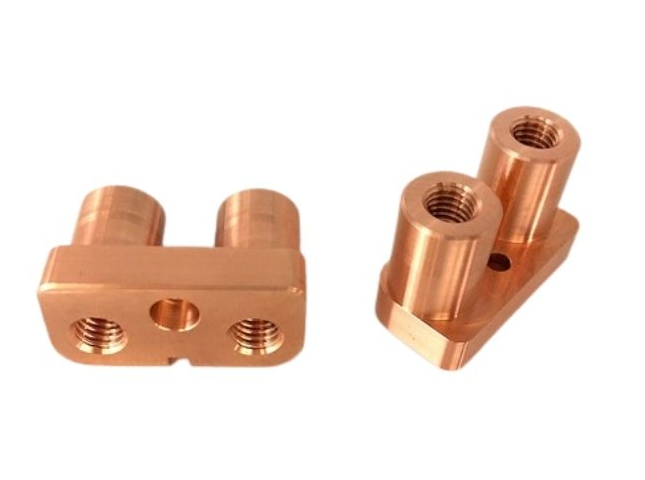CNC copper processing technology involves using computer numerical control (CNC) machines to manufacture copper parts and components. The production process typically involves the following steps:
Making a digital design of the copper part or component using computer-aided design (CAD) software is the first thing that needs to be done in order to get the manufacturing process started. Following the completion of the design, the next step is to write a program for the CNC machine that will be used to fabricate the component of the product. By following the instructions provided by this program, the machine will successfully cut and form the copper into the required component. The copper material is fastened down to the work surface of the CNC machine, and the cutting tool is positioned in accordance with the instructions that were programmed into the machine. In accordance with the instructions that were previously programmed into the CNC machine, a material-cutting tool like a mill or drill is utilized in order to remove material from the copper workpiece. In order to create the component with the desired dimensions and shape, the cutting tool will move along multiple axes as it follows the path that has been programmed. After the machining process is complete, the component may then go through additional finishing processes, such as polishing, deburring, or surface treatment, in order to enhance either its appearance or its functionality. At this point, the finished part is subjected to a final inspection to determine whether or not it satisfies the required specifications and quality standards.
The specific details of the production process may vary depending on the particular CNC machine, tooling, and part design being used.

What Are the Main Characteristics of CNC Machining Copper Parts Compared with Other Metals
CNC machining of copper parts has several distinct characteristics compared to other metals, including:
-Softness: Because copper is a relatively soft metal, it can be machined quickly and easily using CNC technology. This is due to the metal’s softness. Because of this, copper components have the potential to shorten the useful life of cutting tools more rapidly than harder metals.
-High thermal conductivity: Copper is an excellent heat conductor, which can cause issues during the machining process if the heat generated during cutting is not properly managed. Copper can cause these issues because of its high melting point and low specific heat.
-High electrical conductivity: Because it is such a good conductor of electricity, copper is frequently used in the construction of electronic and electrical parts and components.
-Ductility: Copper is a very ductile metal, which means that it can be easily shaped and formed without breaking or cracking.
-Corrosion resistance: Because of its high resistance to corrosion, copper is frequently used in the construction of components that will be placed in hostile environments.
When compared to other metals, the primary benefits of CNC machining copper parts are their ease of machining, high electrical and thermal conductivity, and resistance to corrosion. In addition, copper parts have a high conductivity of electricity. Copper is also an excellent material for applications that require high ductility and formability. Nevertheless, when compared to other metals such as steel or aluminum, copper may cause cutting tools to be worn down more quickly and generate more heat during the machining process. This can have an effect on the accuracy of the part that is ultimately produced. As a consequence of this, specialized machining strategies and equipment might be required in order to guarantee the high precision and quality of copper components.
After the surface protection treatment of CNC machined copper parts, can it maintain a bright and new appearance and corrosion resistance and oxidation resistance for a long time?
CNC machined copper parts can be treated with various surface protection treatments to maintain their appearance and prevent corrosion and oxidation. However, the specific effectiveness and durability of these treatments will depend on several factors, including the type of treatment used, the environment in which the part will be used, and how well the treatment is maintained over time.
Some common surface protection treatments for CNC machined copper parts include:
-Plating: Copper parts can be plated with other metals, such as nickel, silver, or gold, to improve their appearance and protect against corrosion and oxidation.
-Coating: Coatings such as lacquers or clear coats can be applied to copper parts to protect the surface from oxidation and discoloration.
-Anodizing: Anodizing involves creating a protective oxide layer on the surface of the copper part, which can improve its corrosion resistance and appearance.
-Chemical treatment: Copper parts can be treated with chemicals such as phosphoric acid or chromate to improve their resistance to corrosion and oxidation.
Copper parts that have been CNC machined can have their appearance and corrosion resistance maintained for an extended period of time with the help of these surface protection treatments, provided that they are applied and maintained properly. However, it is essential to keep in mind that every treatment for surface protection has its own set of limitations and has the potential to eventually become worn down or damaged over time. As a result of this, it is essential to make sure that the treatment that is chosen is appropriate for the given application and environment, as well as to ensure that the treatment is properly maintained and monitored over time so that it can continue to be effective.